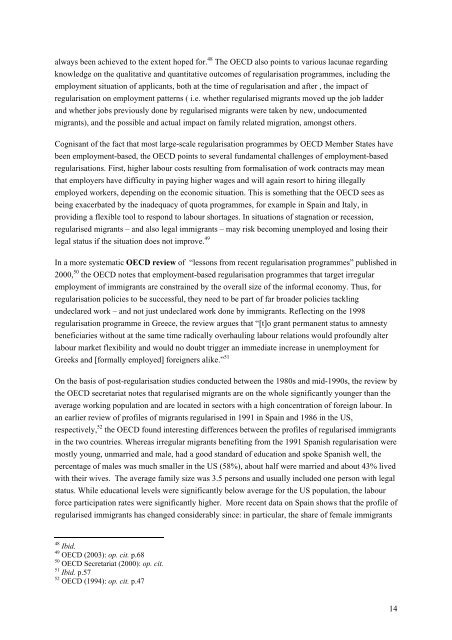REGINE Regularisations in Europe Final Report - European ...
REGINE Regularisations in Europe Final Report - European ...
REGINE Regularisations in Europe Final Report - European ...
Create successful ePaper yourself
Turn your PDF publications into a flip-book with our unique Google optimized e-Paper software.
always been achieved to the extent hoped for. 48 The OECD also po<strong>in</strong>ts to various lacunae regard<strong>in</strong>g<br />
knowledge on the qualitative and quantitative outcomes of regularisation programmes, <strong>in</strong>clud<strong>in</strong>g the<br />
employment situation of applicants, both at the time of regularisation and after , the impact of<br />
regularisation on employment patterns ( i.e. whether regularised migrants moved up the job ladder<br />
and whether jobs previously done by regularised migrants were taken by new, undocumented<br />
migrants), and the possible and actual impact on family related migration, amongst others.<br />
Cognisant of the fact that most large-scale regularisation programmes by OECD Member States have<br />
been employment-based, the OECD po<strong>in</strong>ts to several fundamental challenges of employment-based<br />
regularisations. First, higher labour costs result<strong>in</strong>g from formalisation of work contracts may mean<br />
that employers have difficulty <strong>in</strong> pay<strong>in</strong>g higher wages and will aga<strong>in</strong> resort to hir<strong>in</strong>g illegally<br />
employed workers, depend<strong>in</strong>g on the economic situation. This is someth<strong>in</strong>g that the OECD sees as<br />
be<strong>in</strong>g exacerbated by the <strong>in</strong>adequacy of quota programmes, for example <strong>in</strong> Spa<strong>in</strong> and Italy, <strong>in</strong><br />
provid<strong>in</strong>g a flexible tool to respond to labour shortages. In situations of stagnation or recession,<br />
regularised migrants – and also legal immigrants – may risk becom<strong>in</strong>g unemployed and los<strong>in</strong>g their<br />
legal status if the situation does not improve. 49<br />
In a more systematic OECD review of “lessons from recent regularisation programmes” published <strong>in</strong><br />
2000, 50 the OECD notes that employment-based regularisation programmes that target irregular<br />
employment of immigrants are constra<strong>in</strong>ed by the overall size of the <strong>in</strong>formal economy. Thus, for<br />
regularisation policies to be successful, they need to be part of far broader policies tackl<strong>in</strong>g<br />
undeclared work – and not just undeclared work done by immigrants. Reflect<strong>in</strong>g on the 1998<br />
regularisation programme <strong>in</strong> Greece, the review argues that “[t]o grant permanent status to amnesty<br />
beneficiaries without at the same time radically overhaul<strong>in</strong>g labour relations would profoundly alter<br />
labour market flexibility and would no doubt trigger an immediate <strong>in</strong>crease <strong>in</strong> unemployment for<br />
Greeks and [formally employed] foreigners alike.” 51<br />
On the basis of post-regularisation studies conducted between the 1980s and mid-1990s, the review by<br />
the OECD secretariat notes that regularised migrants are on the whole significantly younger than the<br />
average work<strong>in</strong>g population and are located <strong>in</strong> sectors with a high concentration of foreign labour. In<br />
an earlier review of profiles of migrants regularised <strong>in</strong> 1991 <strong>in</strong> Spa<strong>in</strong> and 1986 <strong>in</strong> the US,<br />
respectively, 52 the OECD found <strong>in</strong>terest<strong>in</strong>g differences between the profiles of regularised immigrants<br />
<strong>in</strong> the two countries. Whereas irregular migrants benefit<strong>in</strong>g from the 1991 Spanish regularisation were<br />
mostly young, unmarried and male, had a good standard of education and spoke Spanish well, the<br />
percentage of males was much smaller <strong>in</strong> the US (58%), about half were married and about 43% lived<br />
with their wives. The average family size was 3.5 persons and usually <strong>in</strong>cluded one person with legal<br />
status. While educational levels were significantly below average for the US population, the labour<br />
force participation rates were significantly higher. More recent data on Spa<strong>in</strong> shows that the profile of<br />
regularised immigrants has changed considerably s<strong>in</strong>ce: <strong>in</strong> particular, the share of female immigrants<br />
48 Ibid.<br />
49 OECD (2003): op. cit. p.68<br />
50 OECD Secretariat (2000): op. cit.<br />
51 Ibid. p.57<br />
52 OECD (1994): op. cit. p.47<br />
14
















